Search Result
Results for "
dephosphorylation
" in MedChemExpress (MCE) Product Catalog:
2
Biochemical Assay Reagents
3
Isotope-Labeled Compounds
| Cat. No. |
Product Name |
Target |
Research Areas |
Chemical Structure |
-
- HY-N9326
-
|
|
Phosphatase
|
Metabolic Disease
|
|
Uralenol is a natural PTP1B inhibitor (IC50=21. 5 μM) from Broussonetia papyrifera. PTP1B have been shown to play a major role in the dephosphorylation of the insulin receptor in many cellular and biochemical studies .
|
-
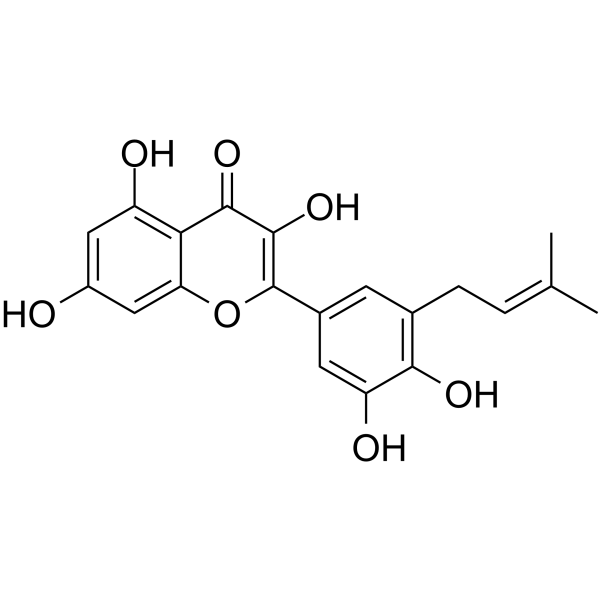
-
- HY-D0199
-
|
|
Endogenous Metabolite
|
Cardiovascular Disease
|
|
Adenosine 5'-diphosphate disodium is a nucleoside diphosphate. Adenosine 5'-diphosphate disodium is the product of ATP dephosphorylation by ATPases. Adenosine 5'-diphosphate disodium is a platelet aggregation agent for hemostasis and the development and extension of arterial thrombosis .
|
-

-
- HY-P1026
-
-
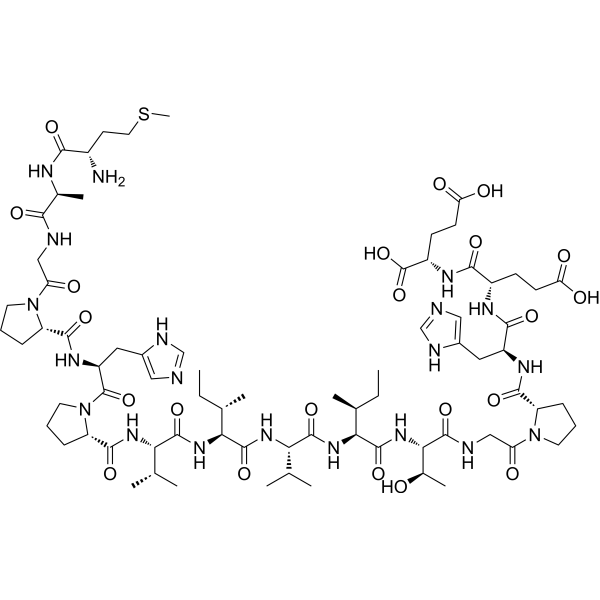
-
- HY-112395
-
|
|
Polo-like Kinase (PLK)
|
Others
|
|
BTO-1 is a Polo-like kinase (Plk) inhibitor. BTO-1 is primarily used for phosphorylation and dephosphorylation applications .
|
-
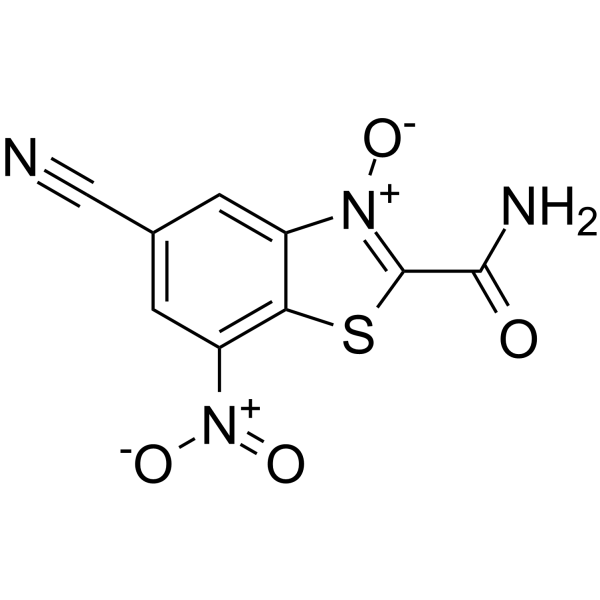
-
- HY-B1829
-
|
Dexamethasone 21-phosphate
|
Glucocorticoid Receptor
|
Inflammation/Immunology
|
|
Dexamethasone phosphate (Dexamethasone 21-phosphate) is a biologically inactive compound which undergoes dephosphorylation by intra-erythrocyte enzymes. The active metabolite, dexamethasone, is then released into the circulation by simple passive diffusion through cell membranes. Dexamethasone phosphate-encapsulated erythrocyte has the potential for steroid-dependent ulcerative colitis research .
|
-
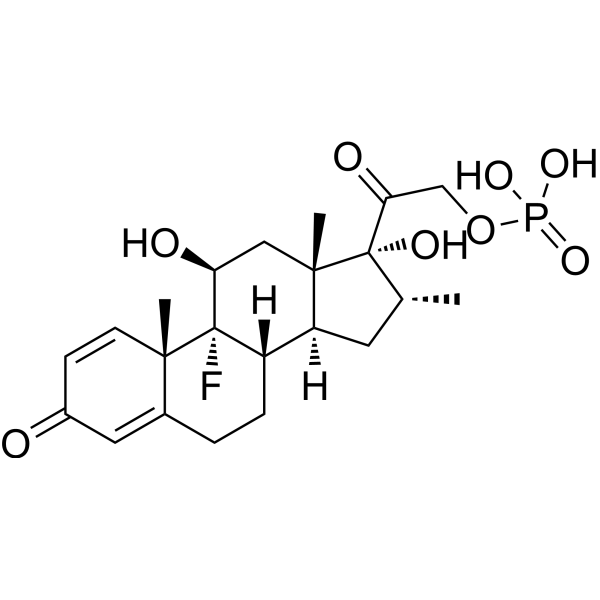
-
- HY-150641
-
|
|
CDK
Apoptosis
DNA/RNA Synthesis
|
Cancer
|
|
CDK-IN-9 (compound 24) is a potent CDK inhibitor, also as a molecular glue inducing an interaction between CDK12 and DDB1, with an IC50 values of 4 nM for CDK2/E. CDK-IN-9 leads to polyubiquitination of cyclin K and its subsequent degradation. CDK-IN-9 induce apoptosis through dephosphorylation of retinoblastoma protein and RNA polymerase II .
|
-
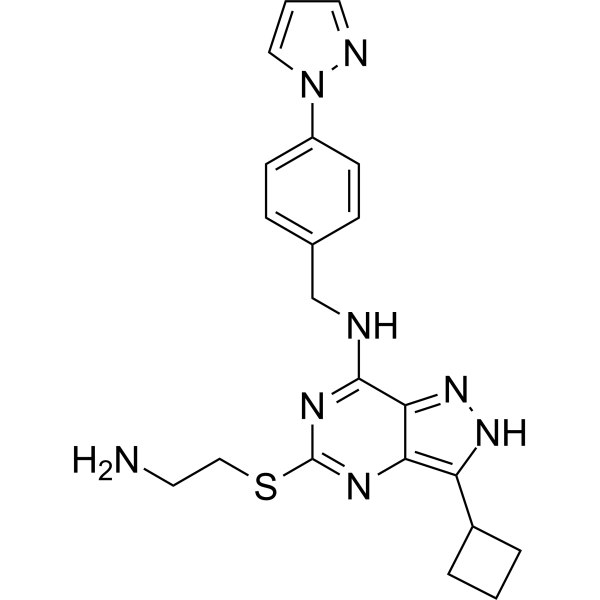
-
- HY-120035
-
|
|
Proteasome
Ribosomal S6 Kinase (RSK)
Apoptosis
|
Cancer
|
|
DD1, a proteasome inhibitor, targets Bax activation and P70S6K degradation during acute myeloid leukemia (AML) apoptosis. DD1 induces apoptosis in the caspase-dependent manner. DD1 induces mitochondrial membrane depolarization and Bad dephosphorylation .
|
-
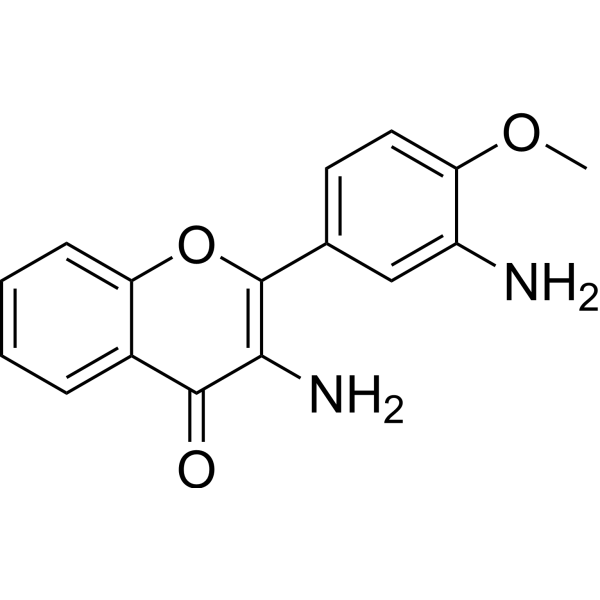
-
- HY-145232
-
|
|
PROTACs
|
Others
|
|
Similar to PROTACs in their ability to induce ternary complexes, PhosTAC7 focuses on recruiting a Ser/Thr phosphatase to a phosphosubstrate to mediate its dephosphorylation.
|
-
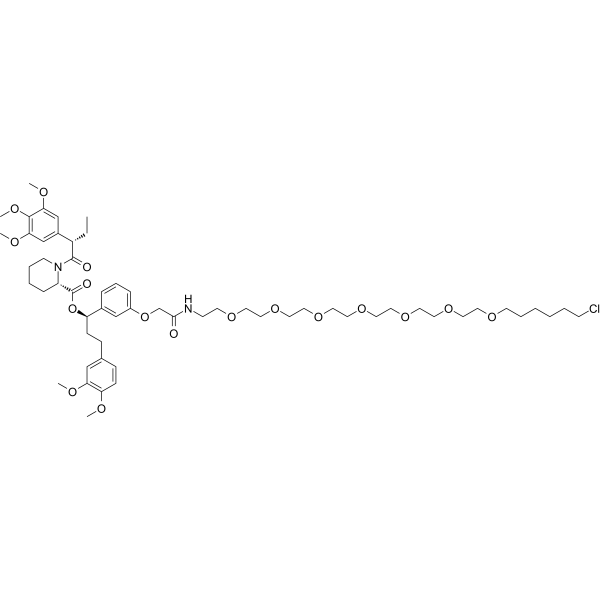
-
- HY-113284
-
|
N6-Succinyl adenosine
|
Endogenous Metabolite
|
Metabolic Disease
|
|
Succinyladenosine, the metabolic product of dephosphorylation of intracellular adenylosuccinic acid (S-AMP) by cytosolic 5-nucleotidase, is a biochemical marker of adenylosuccinase (ASL) deficiency .
|
-
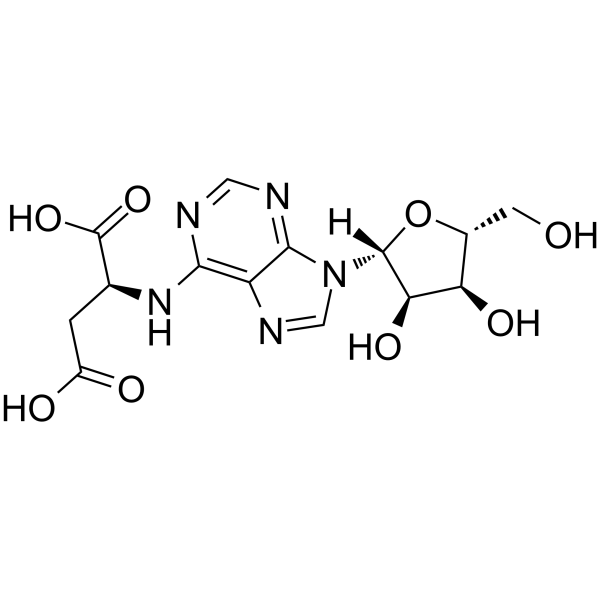
-
- HY-W089922
-
|
Erythrosphingosine hydrochloride; erythro-C18-Sphingosine hydrochloride; trans-4-Sphingenine hydrochloride
|
TRP Channel
|
Neurological Disease
|
|
D-erythro-Sphingosine (Erythrosphingosine) hydrochloride is a specific TRPM3 activator. D-erythro-Sphingosine also induces retinoblastoma protein dephosphorylation .
|
-
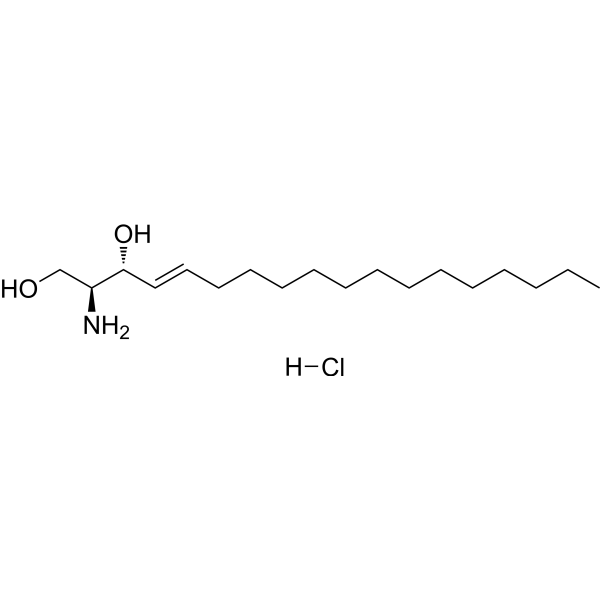
-
- HY-15486
-
Salubrinal
Maximum Cited Publications
20 Publications Verification
|
Phosphatase
HSV
Autophagy
Apoptosis
|
Infection
Inflammation/Immunology
Cancer
|
|
Salubrinal is a cell-permeable and selective inhibitor of eIF2α dephosphorylation . Salubrinal acts as a dual-specificity phosphatase 2 (Dusp2) inhibitor and suppresses inflammation in anti-collagen antibody-induced arthritis . Salubrinal has antiviral activity against HSV-1 and inhibits dephosphorylation of eIF2α mediated by the HSV-1 protein ICP34.5 .
|
-

-
- HY-148509
-
|
|
Others
|
Cancer
|
|
PhosTAC5 is a phosphorylation targeting chimera (PhosTAC) molecule composed of a linker with fivePEG groups. PhosTAC5 induces dephosphorylation of PDCD4 and FOXO3a .
|
-

-
- HY-B0278
-
|
Zinc bacitracin
|
Bacterial
Antibiotic
|
Infection
|
|
Bacitracin Zinc (Zinc bacitracin) is a dephosphorylation of the C55-isoprenyl pyrophosphate interference for inhibition of cleavage of Tyr from Met-enkephalin with IC50 of 10 μM.
|
-
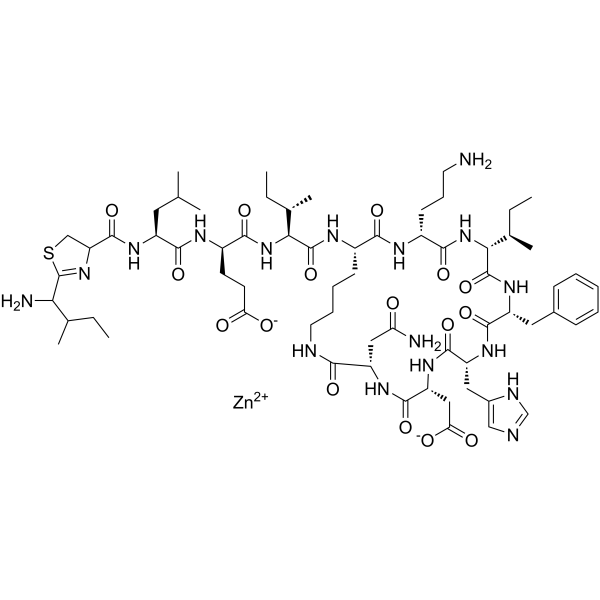
-
- HY-148508
-
|
|
Others
|
Cancer
|
|
PhosTAC3 is a phosphorylation targeting chimera (PhosTAC) molecule composed of a linker with three PEG groups. PhosTAC3 induces dephosphorylation of PDCD4 and FOXO3a .
|
-

-
- HY-112800
-
|
|
Phosphatase
|
Metabolic Disease
|
|
cyt-PTPε Inhibitor-1 is a potent cytosolic protein tyrosine phosphatase epsilon (cyt-PTPε) inhibitor, binds to the catalytic domain of cyt-PTPε, blocks c-Src activation (dephosphorylation of c-Src), and exhibits anti-osteoclastic activity .
|
-
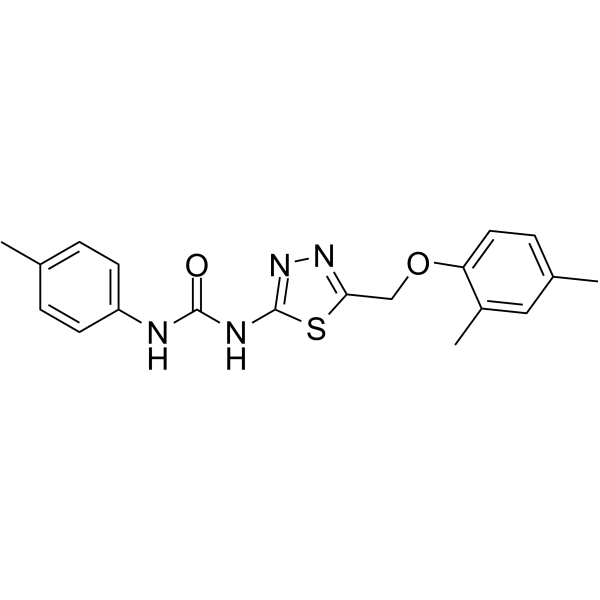
-
- HY-W010791
-
|
|
Endogenous Metabolite
|
Others
|
|
Adenosine 5'-diphosphate (ADP) sodium salt is a nucleoside diphosphate, which is the product of ATP dephosphorylation by ATPases. Adenosine 5'-diphosphate sodium salt induces human platelet aggregation and inhibits stimulated adenylate cyclase by an action at P2T-purinoceptors .
|
-
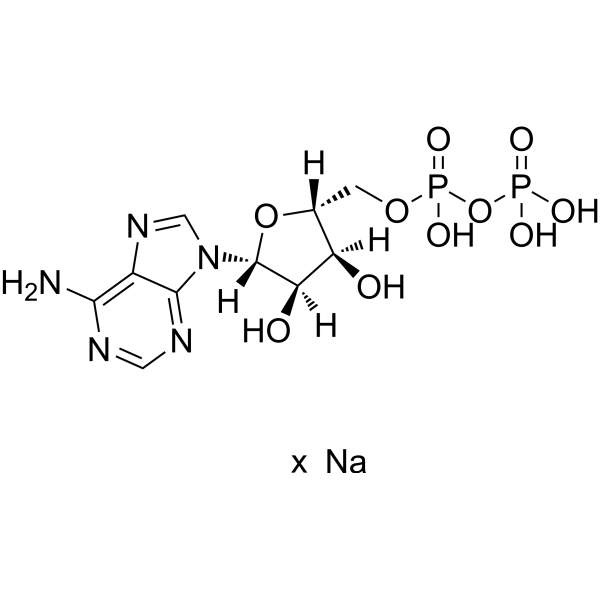
-
- HY-W010918
-
|
Adenosine diphosphate; ADP
|
Endogenous Metabolite
|
Others
|
|
Adenosine 5'-diphosphate (Adenosine diphosphate) is a nucleoside diphosphate. Adenosine 5'-diphosphate is the product of ATP dephosphorylation by ATPases. Adenosine 5'-diphosphate induces human platelet aggregation and inhibits stimulated adenylate cyclase by an action at P2T-purinoceptors.
|
-
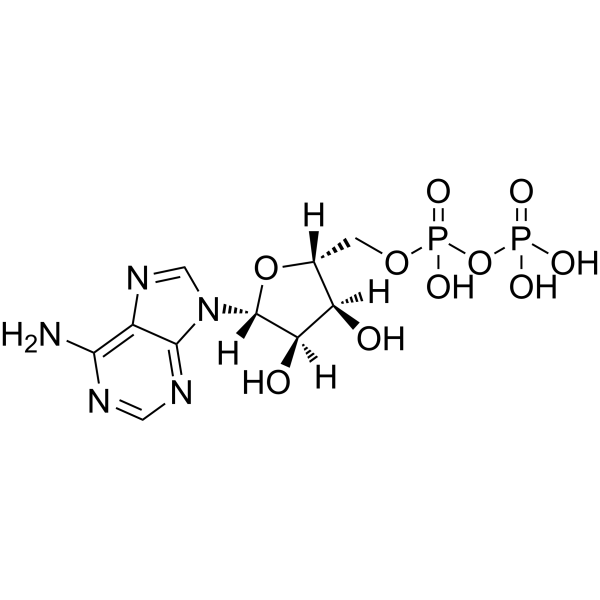
-
- HY-112233
-
O-304
3 Publications Verification
|
AMPK
|
Cardiovascular Disease
Metabolic Disease
|
|
O-304 is a first-in-class, orally available pan-AMPK activator, which increases AMPK activity by suppressing the dephosphorylation of pAMPK. O-304 exhibits a great potential as a agent to treat type 2 diabetes (T2D) and associated cardiovascular complications .
|
-
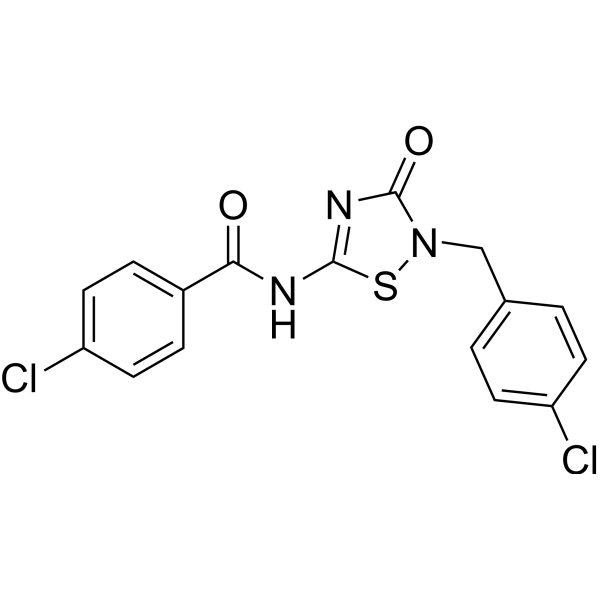
-
- HY-111022
-
|
Sephin1; IFB-088
|
Phosphatase
|
Infection
Inflammation/Immunology
|
|
Icerguastat (Sephin1), a derivative of Guanabenz lacking the α2-adrenergic activity, is a selective inhibitor of the phosphatase regulatory subunit PPP1R15A (R15A). Icerguastat inhibits eIF2α dephosphorylation, thereby prolonging the protective response. Anti-prion effect .
|
-

-
- HY-110365
-
|
Sephin1 Carbonate; IFB-088 Carbonate
|
Phosphatase
|
Infection
|
|
Icerguastat (Sephin1) Carbonate, a derivative of Guanabenz lacking the α2-adrenergic activity, is a selective inhibitor of the phosphatase regulatory subunit PPP1R15A (R15A). Icerguastat Carbonate inhibits eIF2α dephosphorylation, thereby prolonging the protective response. Anti-prion effect .
|
-

-
- HY-W104368
-
-
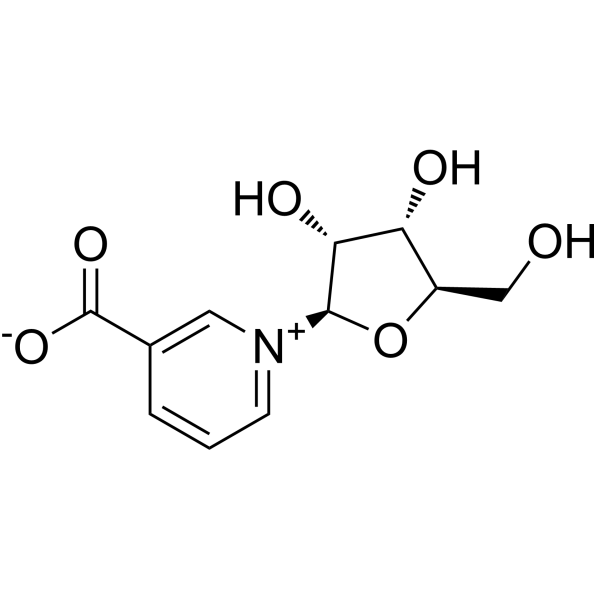
-
- HY-13285
-
|
Debio 0719
|
LPL Receptor
|
Neurological Disease
Cancer
|
|
Ki16425 (Debio 0719) is a subtype-selective, competitive antagonist of the EDG-family receptors, LPA1 and LPA3 with Kis of 0.34 μM and 0.93 μM, respectively. Ki16425 (Debio 0719) reduces the LPA-induced activation of p42/p44 MAPK . Ki16425 can also inhibit LPA-induced dephosphorylation of Yes-associated protein (YAP)/TAZ in HEK293A cells .
|
-
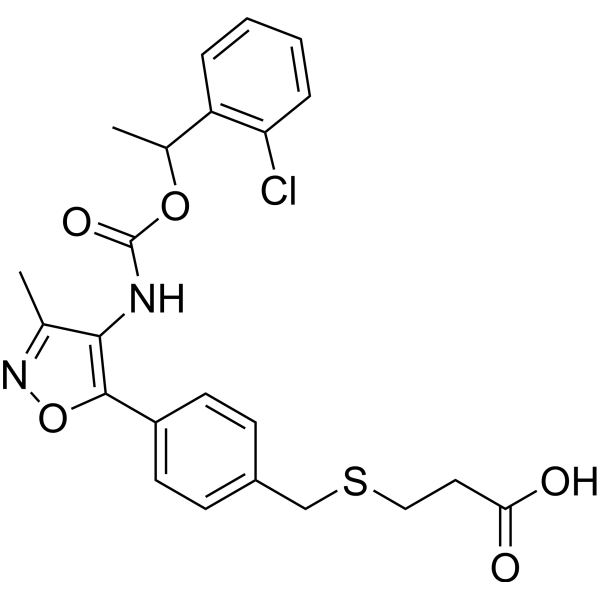
-
- HY-143660
-
|
|
Microtubule/Tubulin
Apoptosis
|
Cancer
|
|
LG308 is a novel synthetic compound with antimicrotubule activity. LG308 induces mitotic phase arrest and inhibits G2/M progression significantly which is associated with the upregulation of cyclin B1 and mitotic marker MPM-2 and the dephosphorylation of cdc2. LG308 also induces apoptosis and cell death. LG308 significantly suppresses tumor growth. LG308 with antimitotic activity has the potential for the research of prostate cancer .
|
-

-
- HY-115463
-
EB-3D
1 Publications Verification
|
AMPK
Apoptosis
|
Cancer
|
|
EB-3D is a potent and selective choline kinase α (ChoKα) inhibitor, with an IC50 of 1 μM for ChoKα1. EB-3D exerts effects on ChoKα expression, AMPK activation, apoptosis, endoplasmic reticulum stress and lipid metabolism. EB-3D exhibits a potent antiproliferative activity in a panel of T-leukemia cell lines. Anti-cancer activity .
|
-
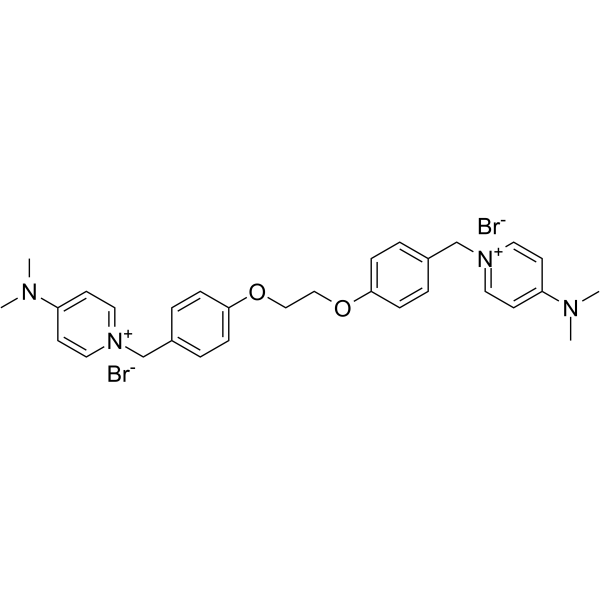
-
- HY-155245
-
|
|
CDK
Bcl-2 Family
|
Cancer
|
|
A09-003 is a CDK-9 inhibitor (IC50: 16 nM). A09-003 inhibits leukemia cell proliferation (IC50: 1.90, 0.86, 2.49, 1.84, 0.48 μM for BDCM, Molm-14, THP-1, U937, MV4-11 cells). A09-003 induces apoptosis and decreases Mcl-1 expression through Thr163 dephosphorylation .
|
-

-
- HY-W010918S
-
|
Adenosine diphosphate-d13 dilithium; ADP--d13 dilithium
|
Isotope-Labeled Compounds
Endogenous Metabolite
|
Others
|
|
Adenosine 5'-diphosphate-d13 (Adenosine diphosphate-d13 dilithium; ADP-d13) dilithium is deuterium labeled Adenosine 5'-diphosphate (HY-W010918). Adenosine 5'-diphosphate (Adenosine diphosphate) is a nucleoside diphosphate. Adenosine 5'-diphosphate is the product of ATP dephosphorylation by ATPases. Adenosine 5'-diphosphate induces human platelet aggregation and inhibits stimulated adenylate cyclase by an action at P2T-purinoceptors.
|
-

-
- HY-W010918S1
-
|
Adenosine diphosphate-13C10 dilithium; ADP-13C10 dilithium
|
Isotope-Labeled Compounds
Endogenous Metabolite
|
Others
|
|
Adenosine 5'-diphosphate- 13C10 (Adenosine diphosphate- 13C10 dilithium; ADP- 13C10) dilithium is 13C-labeled Adenosine 5'-diphosphate (HY-W010918). Adenosine 5'-diphosphate (Adenosine diphosphate) is a nucleoside diphosphate. Adenosine 5'-diphosphate is the product of ATP dephosphorylation by ATPases. Adenosine 5'-diphosphate induces human platelet aggregation and inhibits stimulated adenylate cyclase by an action at P2T-purinoceptors.
|
-

-
- HY-W010918S2
-
|
Adenosine diphosphate-15N5 dilithium; ADP-15N5 dilithium
|
Isotope-Labeled Compounds
Endogenous Metabolite
|
Others
|
|
Adenosine 5'-diphosphate- 15N5 (Adenosine diphosphate- 15N5 dilithium; ADP- 15N5) dilithium is 15N labeled Adenosine 5'-diphosphate (HY-W010918). Adenosine 5'-diphosphate (Adenosine diphosphate) is a nucleoside diphosphate. Adenosine 5'-diphosphate is the product of ATP dephosphorylation by ATPases. Adenosine 5'-diphosphate induces human platelet aggregation and inhibits stimulated adenylate cyclase by an action at P2T-purinoceptors.
|
-

-
- HY-18676
-
|
|
Integrin
Autophagy
Apoptosis
|
Cancer
|
|
OSU-T315 (ILK-IN-1) is a small Integrin-linked kinase (ILK) inhibitor with an IC50 of 0.6 μM, inhibiting PI3K/AKT signaling by dephosphorylation of AKT-Ser473 and other ILK targets (GSK-3β and myosin light chain) . OSU-T315 abrogates AKT activation by impeding AKT localization in lipid rafts and triggers caspase-dependent apoptosis in an ILK-independent manner . OSU-T315 causes cell death through apoptosis and autophagy .
|
-
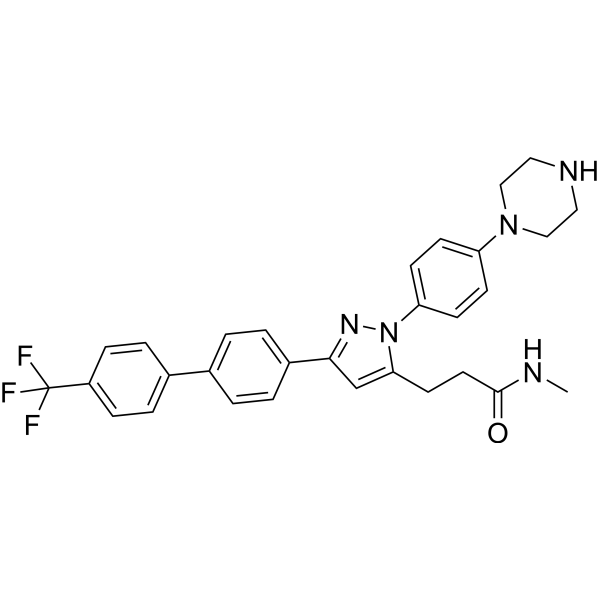
-
- HY-W058849
-
|
|
AMPK
mTOR
Apoptosis
|
Cancer
|
|
MT 63-78 is a specific and potent direct AMPK activator with an EC50 of 25 μM. MT 63–78 also induces cell mitotic arrest and apoptosis. MT 63-78 blocks prostate cancer growth by inhibiting the lipogenesis and mTORC1 pathways. MT 63-78 has antitumor effects .
|
-
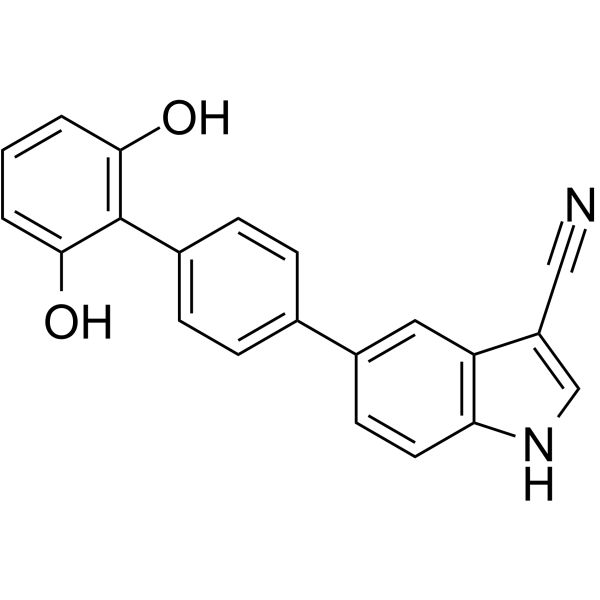
-
- HY-W251428
-
|
|
Biochemical Assay Reagents
|
Others
|
|
Phosphatidylglycerol is a naturally occurring anionic phospholipid that is a component of plant, animal and bacterial cell membranes. It is present in prokaryotes and eukaryotes less than phosphatidylethanolamine, and in eukaryotes less than phosphatidylcholine. It is formed by the reaction between CDP-diglyceride and L-α-glycerol 3-phosphate followed by dephosphorylation and is the metabolic precursor of cardiolipin. Phosphatidylglycerols containing polyunsaturated and monounsaturated fatty acyl chains inhibit and promote the proliferation of murine keratinocytes, respectively. Phosphatidylglycerol is the second-largest lipid component of mammalian lung surfactant, accounting for 10% of lipids, and has reduced levels of pulmonary surfactant in infants with respiratory distress syndrome. Phosphatidylglycerol (egg) is a mixture of phosphatidylglycerols isolated from eggs with various fatty acyl groups at the sn-1 and sn-2 positions. References: [1]. Ohtsuka, T., Nishijima, M., and Akamatsu, Y. Phosphatidylglycerol phosphate synthase-deficient somatic mutants with impaired phosphatidylglycerol and cardiolipin biosynthesis J. Biol. Chemical. 268(30), 22908-22913 (1993).[2]. Furse, S. Are phosphatidylglycerols essential for terrestrial life J. Chemistry. biology. 10(1), 1-9 (2016).[3]. Xie, D., Seremwe, M., Edwards, JG, et al. Different effects of different phosphatidylglycerols on the proliferation of mouse keratinocytes PLoS One 9(9), e107119 (2014).
|
-

| Cat. No. |
Product Name |
Type |
-
- HY-D0199
-
|
|
Biochemical Assay Reagents
|
|
Adenosine 5'-diphosphate disodium is a nucleoside diphosphate. Adenosine 5'-diphosphate disodium is the product of ATP dephosphorylation by ATPases. Adenosine 5'-diphosphate disodium is a platelet aggregation agent for hemostasis and the development and extension of arterial thrombosis .
|
-
- HY-W251428
-
|
|
Biochemical Assay Reagents
|
|
Phosphatidylglycerol is a naturally occurring anionic phospholipid that is a component of plant, animal and bacterial cell membranes. It is present in prokaryotes and eukaryotes less than phosphatidylethanolamine, and in eukaryotes less than phosphatidylcholine. It is formed by the reaction between CDP-diglyceride and L-α-glycerol 3-phosphate followed by dephosphorylation and is the metabolic precursor of cardiolipin. Phosphatidylglycerols containing polyunsaturated and monounsaturated fatty acyl chains inhibit and promote the proliferation of murine keratinocytes, respectively. Phosphatidylglycerol is the second-largest lipid component of mammalian lung surfactant, accounting for 10% of lipids, and has reduced levels of pulmonary surfactant in infants with respiratory distress syndrome. Phosphatidylglycerol (egg) is a mixture of phosphatidylglycerols isolated from eggs with various fatty acyl groups at the sn-1 and sn-2 positions. References: [1]. Ohtsuka, T., Nishijima, M., and Akamatsu, Y. Phosphatidylglycerol phosphate synthase-deficient somatic mutants with impaired phosphatidylglycerol and cardiolipin biosynthesis J. Biol. Chemical. 268(30), 22908-22913 (1993).[2]. Furse, S. Are phosphatidylglycerols essential for terrestrial life J. Chemistry. biology. 10(1), 1-9 (2016).[3]. Xie, D., Seremwe, M., Edwards, JG, et al. Different effects of different phosphatidylglycerols on the proliferation of mouse keratinocytes PLoS One 9(9), e107119 (2014).
|
| Cat. No. |
Product Name |
Target |
Research Area |
| Cat. No. |
Product Name |
Category |
Target |
Chemical Structure |
| Cat. No. |
Product Name |
Chemical Structure |
-
- HY-W010918S
-
|
|
|
Adenosine 5'-diphosphate-d13 (Adenosine diphosphate-d13 dilithium; ADP-d13) dilithium is deuterium labeled Adenosine 5'-diphosphate (HY-W010918). Adenosine 5'-diphosphate (Adenosine diphosphate) is a nucleoside diphosphate. Adenosine 5'-diphosphate is the product of ATP dephosphorylation by ATPases. Adenosine 5'-diphosphate induces human platelet aggregation and inhibits stimulated adenylate cyclase by an action at P2T-purinoceptors.
|
-

-
- HY-W010918S1
-
|
|
|
Adenosine 5'-diphosphate- 13C10 (Adenosine diphosphate- 13C10 dilithium; ADP- 13C10) dilithium is 13C-labeled Adenosine 5'-diphosphate (HY-W010918). Adenosine 5'-diphosphate (Adenosine diphosphate) is a nucleoside diphosphate. Adenosine 5'-diphosphate is the product of ATP dephosphorylation by ATPases. Adenosine 5'-diphosphate induces human platelet aggregation and inhibits stimulated adenylate cyclase by an action at P2T-purinoceptors.
|
-

-
- HY-W010918S2
-
|
|
|
Adenosine 5'-diphosphate- 15N5 (Adenosine diphosphate- 15N5 dilithium; ADP- 15N5) dilithium is 15N labeled Adenosine 5'-diphosphate (HY-W010918). Adenosine 5'-diphosphate (Adenosine diphosphate) is a nucleoside diphosphate. Adenosine 5'-diphosphate is the product of ATP dephosphorylation by ATPases. Adenosine 5'-diphosphate induces human platelet aggregation and inhibits stimulated adenylate cyclase by an action at P2T-purinoceptors.
|
-

Your information is safe with us. * Required Fields.
Inquiry Information
- Product Name:
- Cat. No.:
- Quantity:
- MCE Japan Authorized Agent:







































